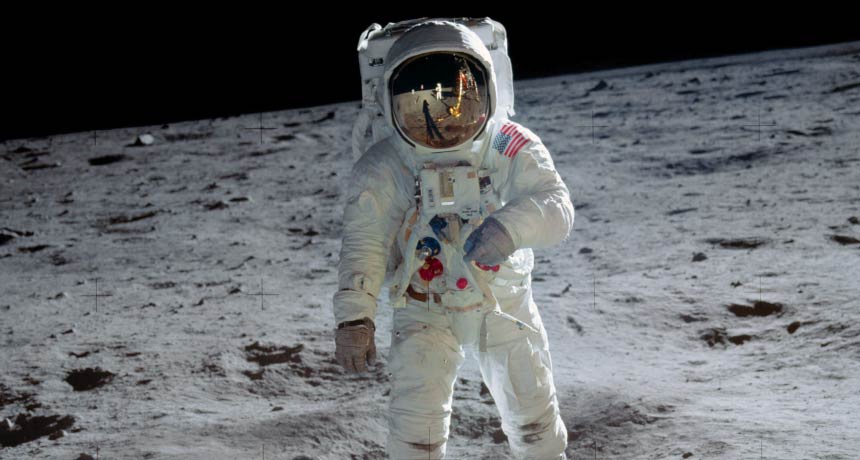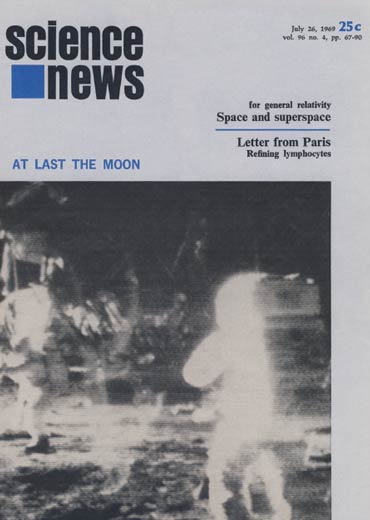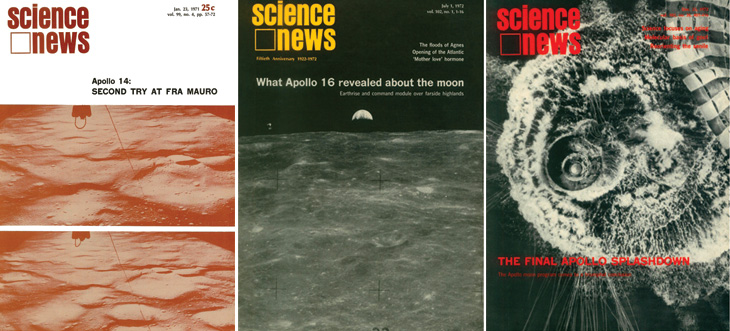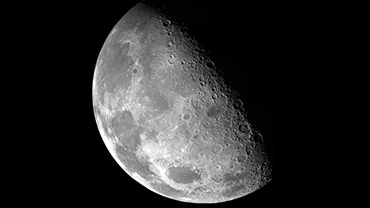Accolades, skepticism and science marked Science News’ coverage of Apollo
Moon landings coverage focused on science, while voicing wary public frustrations

FIRST ON THE MOON There are two astronauts in this 1969 photo. Buzz Aldrin stands on the moon near the Apollo 11 lunar lander while Neil Armstrong, reflected in Aldrin’s visor, takes the picture.
NASA
To cover humankind’s first steps on the moon, Science News needed a backup plan.
“We didn’t know what kind of pictures we’d get, when we would get them, who we would get them from,” says Kendrick Frazier, who joined Science News as a writer just two months before Apollo 11 touched down on lunar soil. So the staff took pictures of their home television screens during the July 20, 1969 broadcast of the moon landing. “It didn’t work out very well,” he says.
Fortunately, images from NASA sufficed. On the cover of the July 26, 1969 issue — just 25 cents! — the words “At last the moon” ran atop a raw, black-and-white image of two blurry forms standing on desolate terrain, with the spidery outline of the lunar lander in the background. A description of the photo — Frazier’s one contribution to the coverage — captured the scene: “Ghostly they were, those two figures gliding over the surface of the moon. But, with all the world watching, it was certain. The dream of the ages had been fulfilled: Man was on the moon.”

“Apollo was an epic achievement. We all were super excited,” Frazier says. Yet the magazine never went overboard, he adds. “We managed to cover all the other things going on in science.” The July 26 issue devoted just five of its 24 pages to the Apollo 11 landing. Other stories included advances in predicting the sex of an unborn child and urban influences on precipitation.
The job of covering Apollo 11 fell to staff writer Jonathan Eberhart. He most likely traveled to Cape Kennedy (now called Cape Canaveral) in Florida for the launch and then to Houston for the rest of the mission, Frazier suspects, filing stories by phone or telegram. In describing the mission, Eberhart’s prose soared: “Now the moon is man’s. The incredible accomplishments of Apollo 11 have changed it irretrievably in the eyes of humankind.” Then he quickly got to work recounting the well-rehearsed descent, the harrowing landing, the hesitant first steps — before spending much of his time, of course, on the science.
Eberhart, who covered space exploration for Science News for three decades, painstakingly described three experiments installed by the Apollo 11 astronauts: a metal foil for snagging solar particles, a seismometer for tracking moonquakes and a mirror array for reflecting lasers back to Earth.
Some geologists, he noted, were miffed about the sample collection: The astronauts didn’t know precisely where they landed and were snatching soil from areas where they had already trod, thus collecting samples from potentially disturbed terrain (SN: 7/26/69, p. 72).
But Eberhart’s coverage wasn’t just about timelines and equipment. In a sidebar tucked in the corner of a page of Apollo 11 coverage, Eberhart asked: “What has happened to awe?” He expresses the challenges of a writer conveying the enormity of the moment while pleading with readers to contemplate what humans had just accomplished.
“Try, briefly, to ignore the flashy rockets and the heroic astronauts. Try to feel the smallness of man and the vastness of what he is doing,” Eberhart wrote. “After two million years, man has stepped out of this world onto another. And, by incredible fortune, we are alive at the instant he did it.”
Eberhart can’t explain what he was thinking; he died in 2003 (SN: 3/1/03, p. 134). But Frazier says that this sidebar captured “Jonathan’s sense of wonder and awe amidst all of his professionalism.”
Early on, magazine editor Warren Kornberg pondered the value of this adventure amid the heavy challenges of the time (SN: 7/26/69, p. 71). “Nothing can mar the glory earned by the astronauts,” Kornberg wrote in a special commentary. But “[t]he verdict of history may well be that, while the world erupted, we ignored the real challenge and chased a rocket trail to the moon.” It’s a sobering note. But Apollo’s achievements overlapped with assassinations, race riots and the unpopular Vietnam War, a truth that Science News had to acknowledge.
“We felt we had a special role of reporting on the science part of the … mission as well as putting it into the broader context,” says Frazier, who became the magazine’s editor in 1971. Kornberg’s editorial, he says, reflected widespread “antipathy about spending this money to go to the moon while the whole country was falling apart socially and politically.”
Letters to the editor published that September echoed Kornberg’s concern (SN: 9/13/69, p. 194). “We are frustrated and ashamed,” wrote one reader.
Three years later, in his own — more optimistic — editorial as Apollo 17 drew near, Frazier wrote: “The misfortune of Apollo is that it was conceived in one era of American history and fulfilled in another.… [I]n a future and less buffeted age, the tarnish will have disappeared, and the Apollo landings on the moon will stand as an unambiguous and unparalleled human achievement” (SN: 10/21/72, p. 259).

Despite the public misgivings, Frazier says it was an incredible time to be writing about science. At his home in Albuquerque, he keeps a memento from his tenure at Science News: the engraving plate used to print the cover of the moon landing issue. He plans to display it in his home office this summer, a nod to the 50th anniversary of Apollo 11. “It is, to me, the greatest souvenir of that time,” he says.
Christopher Crockett, formerly at Science News, is a freelance science writer and editor based in Arlington, Va.
This story appears in the July 6, 2019 & July 20, 2019 issue of Science News with the headline, “How Science News covered the Apollo mission: The magazine reported on every facet of this scientific feat.”








